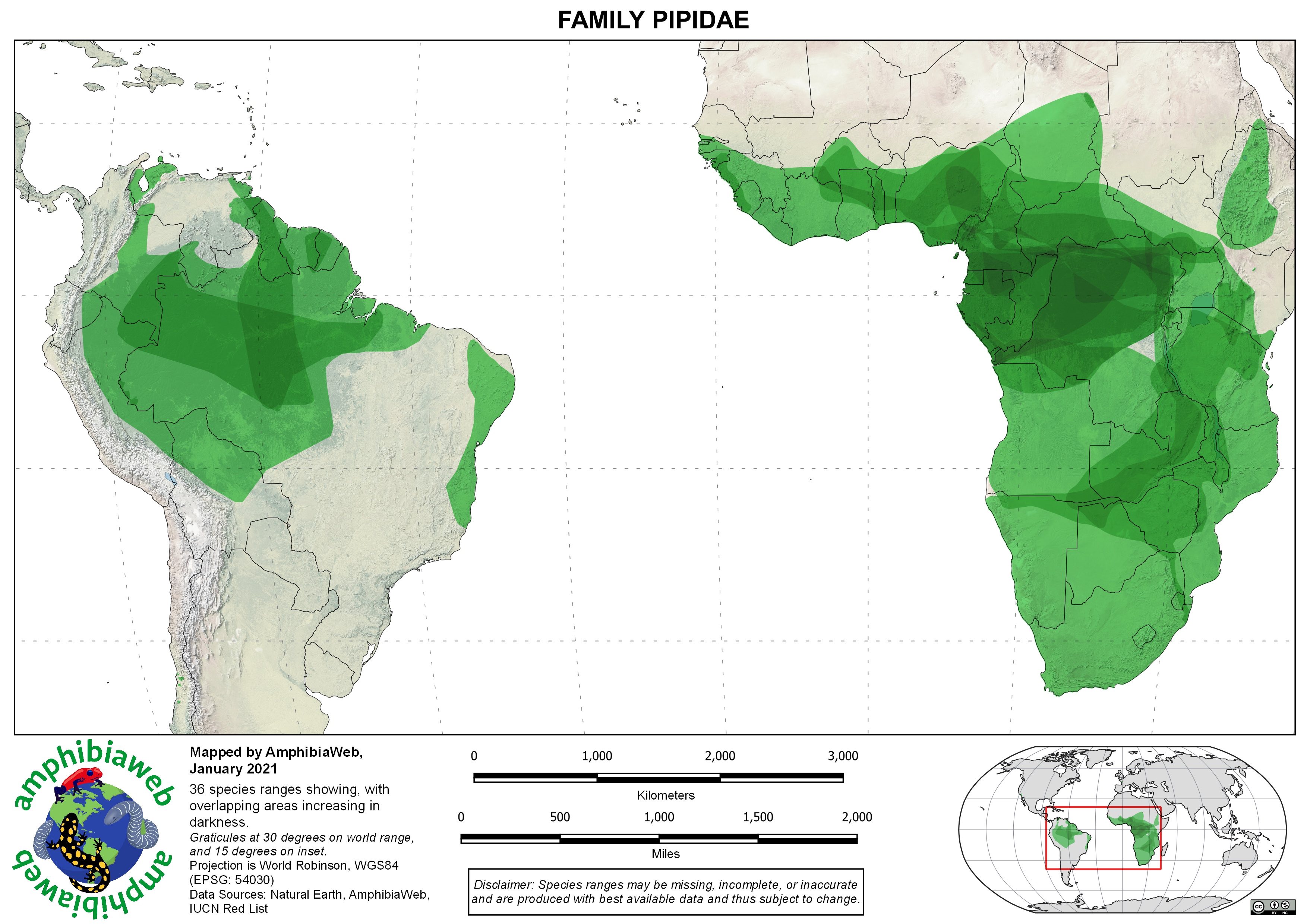Pipidae |
41 species in 4 genera
Commonly Called Tongueless Frogs, African Clawed Frogs, Suriname Toad

Pipa pipa
Photo by Hugo Classen
(Click for family gallery)Members of this family can be found in almost every kind of water body in Africa and South America. Two members of the genus Xenopus have become model lab organisms (the tetraploid Xenopus laevis and more recently the smaller, diploid Xenopus tropicalis), due to their hardiness and ability to be easily maintained in a laboratory, as well as ease of inducing ovulation and mating year-round by gonadotropin injection. The early development of Xenopus laevis has been studied by developmental biologists for over a hundred years.
These frogs lack a tongue, have dorsoventrally flattened bodies, fully webbed hind feet, small dorsally placed eyes, and retain a lateral line system. Tadpoles resemble small catfish due to their paired anterior barbells (absent in Hymenochirus whose tadpoles are carnivorous). Males in this family lack vocal cords but are able to communicate underwater via "clicking" sounds generated through a modified laryngeal apparatus. The Surinam Toad, Pipa pipa, amplexes (mates) in a circular motion underwater, allowing for the eggs to be deposited on the female's back. The fertilized eggs are later enveloped by skin and complete their development within the female's dorsal skin, so that eventually froglets emerge fully formed.
Written by AmphibiaWebNotable Family Characteristics
- Aquatic, living a variety of water bodies, such as lakes, ponds, and streams
- Males lack vocal cords and vocal sacs, but some are known to snap their hyoid apparatus and produce clicking sounds underwater
- Tadpoles may be free-living and resemble small catfish due to their paired anterior barbells (Xenopus), or lack barbells and carnivorous (Hymenochirus), or deposited on females back until hatching as metamorphosed froglets (Pipa)
- Morphological characters include: 1) epipubis present; 2) unpaired epipubic muscle; 3) quadratojugal absent; 4) free ribs in larvae; 5) sacrococcygeal articulation fused; 6) short, stocky sacrum; 7) elongate septomaxillae; 8) lateral line system present in adults; 9) tongues absent; 10) non-pedicellate teeth in Xenopus and some Pipa (other Pipa are edentate, i.e., with very few or no teeth); 10) fully webbed hindfoot; 11) small dorsally oriented eyes; 12) skull palatines absent, single frontoparietal
- Distribution limited to parts of Africa and South America

Cartography Credit: Zoe Yoo, UC Berkeley
Range maps sources: AmphibiaWeb, UC Berkeley, and IUCN RedListRelevant Reference
Pough, F. H., R. M. Andrews, M. L. Crump, A. H. Savitzky, K. D. Wells, and M. C. Brandley. 2015. Herpetology. Fourth Edition. Massachusetts: Sinauer.
Vitt, L. J., and J. P. Caldwell. 2013. Herpetology. An Introductory Biology of Amphibians and Reptiles. Fourth Edition. Amsterdam: Elsevier.
Genus Hymenochirus (4 species)
Hymenochirus boettgeri account photos no sound/video Hymenochirus boulengeri no account no photos no sound/video Hymenochirus curtipes no account photos no sound/video Hymenochirus feae no account no photos no sound/video
Genus Pipa (7 species)
Pipa arrabali no account photos no sound/video Pipa aspera no account photos no sound/video Pipa carvalhoi account photos no sound/video Pipa myersi account photos no sound/video Pipa parva account photos sound/video Pipa pipa account photos no sound/video Pipa snethlageae no account no photos no sound/video
Genus Pseudhymenochirus (1 species)
Pseudhymenochirus merlini no account photos no sound/video
Genus Xenopus (29 species)
Citation: AmphibiaWeb: Information on amphibian biology and conservation. [web application]. Berkeley, California: AmphibiaWeb. Available: https://amphibiaweb.org/. (Accessed:
AmphibiaWeb's policy on data use.
